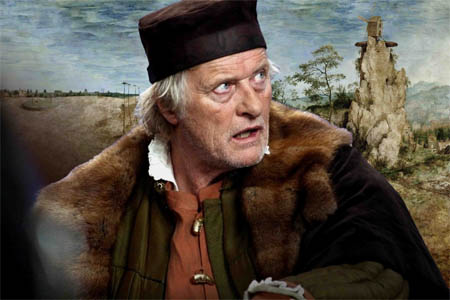Contrary to the popular idea about cinema, and life, I believe that the most important action is not that which moves but that which stands still. I think that people who are caught in the most important moments of their lives, in dramatic moments or moments of bliss, don’t move. They stand still.”
—Lech Majewski, at the 2011 San Francisco International Film Festival (recorded by Michael Guillen)
Lech Majewski’s acclaimed 2011 film, The Mill and the Cross, transcends artistic categorization, a work of 21st-century digital cinema that resurrects a 16th-century painting, Pieter Bruegel’s masterpiece The Way to Calvary. Re-staging the painting with its cast of hundreds while blending actual landscape footage with hand-painted recreations of Bruegel’s canvas, the film is an unprecedented blend of cinema, painting, theater, and scholarship. As film scholar Kristin Thompson remarked upon seeing the film, “What makes The Mill and the Cross so exciting is that it achieves that rarest of things, making us feel that we are seeing something very worthwhile that has never been done before.”
Yet those familiar with Majewski’s filmography may notice in The Mill and the Cross certain motifs and methods from his past works. The following video essay makes a side-by-side comparison of The Mill and the Cross and Majewski’s 1998 film, The Roe’s Room, which happens to be his first film shot on high-definition digital video, and is also available on Fandor. Adapted from a stage opera written and produced by the multi-talented Majewski, The Roe’s Room also features a very painterly sensibility with its precise compositions and delicate visual textures all set in cinematic motion.
[iframe src=”http://player.vimeo.com/video/39126847?title=0&byline=0&portrait=0″ width=”550″ height=”320″ frameborder=”0″ webkitAllowFullScreen mozallowfullscreen allowFullScreen]
This series of comparisons reveals common elements between the two films:
- A canvas-like use of the screen, richly populated with symbolic imagery, individual figures and minute details.
- Tracking camera movements that scroll back and forth like a pendulum, conveying a paradoxical feeling of duration and movement within a frozen moment.
- Interior settings that feature a number of recurring motifs: animals, families gathered at meals, people passing through doorways. Filmed with a rich sense of atmosphere, these motifs convey intimacy and personal significance for Majewski even if their explicit meaning eludes the observer.
- An array of profile shots of figures incorporate frames evoking paintings (and sometimes even explicitly reference other paintings) with hyperbolic contrasts between foreground and background and an affinity for clouds as backdrop.
With all of these motifs there remains a profound sense of stillness, even when the camera is in motion. It’s no surprise that Majewski, originally trained in painting, would be profoundly attuned to stillness; it seems that even when his camera is moving it underscores a frozen essence on screen. Here is what Majewski himself has to say about his affinity to stillness in a conversation with Alec Meacham:
“This is what is called a vertical time, the holy time. The time that stops or is stretched vertically. It’s the artist’s time, somebody who can capture a moment, like in these motionless figures in the paintings. And yet even today, we have many films. We are just swimming in the sea of moving images. We constantly see things on computers and television, but basically what makes up our civilization are stills, because they somehow beat the ephemeral aspect of time.
It’s the incredible power of stillness, which I am fascinated with, because if you’ve seen my movies there’s always this moment of stillness which to me is kind of a holy time. It’s a time of khaos, it is called in Greek. So then the movement suspends or ceases, and when your consciousness heightens, you can capture or go deeper into reality and get these connections between things.”
Kevin B. Lee is Editor in Chief of IndieWire’s PressPlay Video Blog and contributor to Roger Ebert.com. Follow him on Twitter.




